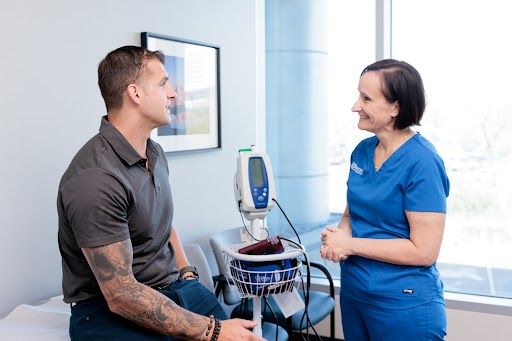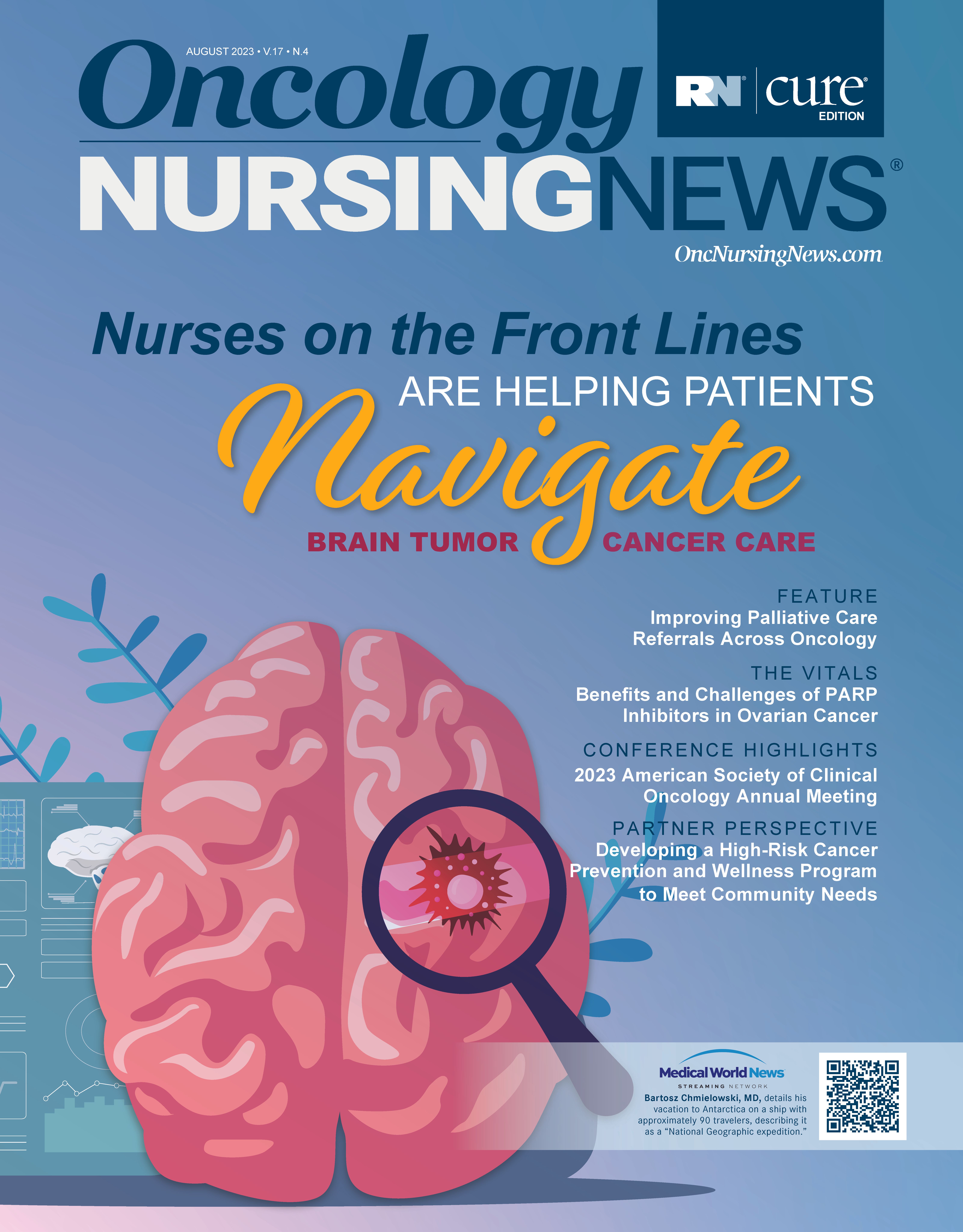Nurses on the Front Lines Are Helping Patients Navigate Brain Tumor Cancer Care
A brain tumor diagnosis can be daunting. Nurses are on the front lines connecting patients to available resources and walking them through the best treatment options.
Compared with that of other oncologic malignancies, the research trajectory of brain tumors could be considered stagnant.
Accounting for approximately 1.3% of all new cancer diagnoses, brain and other central nervous system cancers account for 3.1% of all cancer deaths. Five-year survival rates for patients with these malignancies hover around 33.8%.1 For those with the most common malignant brain tumor—glioblastoma (GBM)—survival rates have not improved over the past 30 years, with the 5-year survival rate of approximately 5% after standard-of-care treatments.2,3
Jenna Tozzi, BA, RN

“GBM is one of the most complex, deadly, and treatment-resistant cancers, accounting for 48%4 of all primary brain tumors,” Jenna Tozzi, BA, RN, said in an interview with Oncology Nursing News, adding that “This tumor type has had virtually unchanged survival and mortality statistics for decades.”
Yet despite a perceived lack of effective treatment options for this patient population, dedicated oncology nurses are at the forefront of care to help guide patients through this daunting journey. Oncology Nursing News spoke to nurses with the Brain Tumor Network and the Ivy Brain Tumor Center at the Barrow Neurological Institute, in Phoenix, Arizona, to better understand how nurses are navigating these difficult diagnoses and where opportunities for newly diagnosed patients reside.
Treatment Challenges
Most patients with gliomas can receive treatment, although very few cases are curable.5 Available treatment options include surgery, chemotherapy, targeted therapy, and radiation therapy. Patients may also be eligible for clinical trials.
As the National Comprehensive Cancer Network (NCCN) guidelines note, many patients with glioma will undergo resection—either a gross total resection to remove all the detectable cancer, or a partial/subtotal resection to remove only a portion of it.5 Some patients may need to be awake during surgery.
Unlike with other solid malignancies such as breast and stomach cancer, it is important that nearby brain tissue is not removed along with the tumor. Advances in surgical imaging have provided surgeons with MRI- or CT-guided scans as aids during surgery.5
For patients who are ineligible for resection or who require additional treatment, the NCCN guidelines include radiation and various systemic therapies. Unfortunately, their efficacy in this patient population is somewhat limited compared with that for other cancer types, explained Tozzi, who is a neuro-oncology nurse navigator and program coordinator with the Brain Tumor Network, and who noted that the blood-brain barrier (BBB) plays a key role in limiting the use of systemic treatments.
The BBB comprises endothelial cells, pericytes, extracellular matrix, and astrocyte end-feet, which reach from the lumen of the brain blood vessel to the brain parenchyma. The BBB is also protected by biochemical pathways. The result is that only 20% of small molecules can cross the BBB and reach tumor cells. Large therapeutics, such as monoclonal antibodies, are essentially locked out.6
“The BBB is [part] of what makes this disease challenging to treat,” Jacki Garcia, BSN, RN, CNRN, a neurosurgical oncology nurse navigator, explained to Oncology Nursing News. “It is this natural protective mechanism the body has so that when we get a cold or some other virus, we don’t get infections in our brain. It is really good at keeping things out. Unfortunately, when we treat brain tumors, it is [also] good at keeping out chemotherapies, which is why we only have a handful of options able to treat these tumors.”
Tozzi concurred that difficulties in drug development to permeate the BBB have stalled advances for patients with brain tumors. “The BBB is so intricate and tightly woven that [although] it does its job well of limiting any harmful contaminant or foreign particles into the brain, it created a monumental challenge in treating brain cancer,” she said. “Finding therapeutic agents that can break through the barrier and reach the tumor cells effectively remains a formidable challenge impacting the advancement of any treatment options.”
Brain Tumor Network
For many patients, the Brain Tumor Network is a valuable resource. This organization seeks to help provide patients with free, individualized navigation, help them manage their primary brain tumor diagnosis, and connect them to quality health care.7
Patients who connect with this organization receive no-cost dual navigation services from both an experienced nurse navigator and a social worker who are educated in primary brain tumor care. Nurse navigators help patients understand their diagnosis, seek out expert second opinions, and investigate available treatment options. Through these navigation services, patients also received a personalized clinical trial search, are connected to financial resources and support groups, and are guided through the process of advance care planning.7
Once patients submit a support form request, they receive an email inviting them to connect with their navigation team either by phone or by video call. Throughout the duration of their time working with their team, they speak with the same navigators to help foster long-lasting relationships. Since launching in 2014, the organization has provided services to over 2400 patients.7
In an interview with Oncology Nursing News, Tozzi and her colleagues, Laura Hynes, MA, BSN, BA, RN, and Kendra Paabo, BSN, RN, explained some of the challenges associated with connecting patients to the best treatment options.
Laura Hynes, MA, BSN, BA, RN

“There are many treatment challenges—including the heterogeneity of these tumors and getting treatments across the BBB,” Hynes, who is director of operations with the Brain Tumor Network, said. “Additionally, a very low number of patients will enroll in clinical trials. Yet trial enrollment is important to help advance research and find a cure where currently no cure exists.”
There are fewer phase 3 trials compared with phase 1 and 2 trials for patients with brain tumors, according to Hynes. Some reasons for this include regulatory requirements, costs, and issues proving efficacy. The consequence is that the percentage of drugs that reach phase 3 trials is relatively low. Nevertheless, nurse navigators with the Brain Tumor Network do what they can to find, and connect their patients with, available clinical trials.
“If a patient is at a critical point in care when a trial may be an appropriate treatment option, we will provide them with a personalized clinical trial search based on their clinical status, tumor pathology, and treatment history,” Paabo, who is manager of patient navigation with the Brain Tumor Network, said. “After presenting the potential trials to a patient, we encourage them to discuss the options with their health care team. We will facilitate trial screening and enrollment on behalf of the patient, along with transferring the necessary medical records.”
Kendra Paabo, BSN, RN

She explained how the nurse navigators with the Brain Tumor Network help patients overcome some of these barriers that are associated with clinical trial enrollment. Many patients, Paabo noted, struggle to navigate ClinicalTrials.gov and/or understand the trial eligibility criteria. Moreover, patients can feel frightened by the prospect of traveling to an outside institution, as traveling can be both stressful and costly.
The nurse navigators with the Brain Tumor Network leverage a proprietary clinical trial matching system to run a personalized search for patients based on their tumor pathology, clinical history, and individual goals, Paabo said. The navigators educate patients on trial requirements and trial design to help them make sense of it all. The navigators also help facilitate the transfer of medical records to initiate the trial screening and enrollment process.
Moving forward, clinical trials continue to represent the best opportunity for advancing treatment for these patients, according to Paabo, so it is important to help connect patients to these opportunities whenever possible.
“Clinical trials can provide new treatments for patients,” she said. “There hasn’t been a change in the newly diagnosed standard of care for glioblastoma since 2005. At recurrence, there is no standard of care. Clinical trials can advance research and potentially find more effective treatment options for patients.
“There have been very few new brain tumor therapies approved in the past 30 years, but recent progress, made in part through government funding, has given us hope,” Hynes added. “Continued progress requires sustained and meaningful increases to federal brain tumor research funding as well as better patient and provider education about viable clinical trial opportunities. We are hopeful that the momentum we are seeing around finding a cure for brain cancer will continue both at the federal and philanthropic levels.”
Phase 0 trials
Phase 0 trials, or window-of-opportunity trials, are unique approaches to brain cancer research that are largely being conducted at the Ivy Brain Tumor Center.8 In 2006, the FDA issued guidance for the conduct of phase 0 trials, which would evaluate novel agents administered below the optimal dose in patients to obtain data on end points such as pharmacokinetic data.3,9 They are not initiated to evaluate therapeutic benefit.3
In neuro-oncology, phase 0 trials have nuances that differ slightly from the standard definition by the FDA for investigative new drug development.3 For example, patients with GBM typically receive anticipated investigational doses of agents to evaluate whether penetration of the BBB is evident. The trial designs can also be integrated with phase 1 or phase 2 protocols for a trial. Should the agents demonstrate therapeutic effect, the patient may be able to continue the treatment in the future.3,9
From left: Kristin Hendrickson, BA, RN; and Jacki Garcia, BSN, RN, CNRN

The basis of the phase 0 trial design is centered around 2 realities: that many new therapeutics are incapable of reaching the brain, and that a drug’s performance in a laboratory animal provides an incomplete picture of how it will perform in a human being, according to Ivy Brain Tumor Center.8
As part of a phase 0 trial, patients must be candidates for surgery, thereby providing a window of time to deliver the investigational agent. Patients receive small amounts of this drug in the days preceding their scheduled resection, and if the drug combination is shown to have penetrated the tumor with the intended effect, they can then continue to receive the drug in a therapeutic setting postresection.3,8,9
Garcia, and Kristin Hendrickson, BA, RN, a research program manager, both with the Ivy Brain Tumor Center,explained what makes an individual a good candidate for a phase 0 trial and how they talk to patients about this treatment option.
“Our phase 0 participants have to be eligible for resection,” Hendrickson said. “We need to be able to give a patient a short subtherapeutic dose of the medication that they are matched with. Then, during surgery, we remove that tissue and other types of specimens, such as blood and cerebrospinal fluid, to determine whether the drug reached its target and if it had its intended biological effect.”
“It is a very basic concept, but it can seem kind of complex,” Garcia added. “I explain that we are trying to put all these treatment options on the table: We have this drug that we feel could offer a potential benefit for you. You can take this drug prior to having surgery—we are going to do the surgery that we would be recommending anyway. Then, when we take the tissue out, we are going to analyze it and make sure that the drug made it into the tissue and is having the effect that we wanted it to have.”
Jacki Garcia, RN, BSN, meets with a patient.

Of note, one of the benefits of a phase 0 trial is it allows investigators to determine whether an agent is penetrating the BBB much sooner than a later-phase trial would allow.
“We can answer those questions within a matter of 2 weeks,” Garcia said. “We’re not losing any time for these patients. If they do not qualify for the phase 2 portion, we are still at that same point that we would have been without the clinical trial.”
“The reason that we do phase 0 trials is that it expedites and quickens the pace of drug development and [allows us] to give promising medications to patients with high-grade gliomas,” Hendrickson said. She added that GBM research, in general, is underfunded and that there is a significant need to improve the drug development and delivery methods for patients with this disease.
“The icing on the cake, so to speak, is that patients who show [evidence of BBB] penetration are given the opportunity to continue taking the medication in a more traditional setting,” she said.
Looking to the Future
Despite the challenges in treating these patients, all the nurses agreed that connecting patients to clinical trials is an important step in helping patients find the best possible treatment for them.
“GBM—which a majority of the patients that I care for have—is a devastating diagnosis, and it is very challenging to treat,” Garcia concluded. “The big thing I always tell peers is: It is not our job to tell the patient what to do, but it is our job to give them every possible treatment option, even if it is not a clinical trial with our institution. As health care providers, we need to make sure that patients are looking at clinical trials and enrolling in them because it is such a challenging disease, and if they are not exploring other avenues, we might be missing a point for them.”
Kristin Hendrickson, BA, RN, discusses treatment options with a patient.

Hendrickson concluded by noting that although the BBB is one significant challenge in treating glioma, research incentive is another. She pointed out that market forces drive research and that pharmaceutical companies consider return investment on experimental agents. She urges innovators to place GBM higher as a research priority moving forward.
“[There are] a lot more diagnoses of breast cancer and lung cancer in the US population than GBM,” Hendrickson said. “But in terms of lives lost, GBM is high on the list and deserves our best scientific efforts to overcome these obstacles.”
References
- Cancer stat facts: brain and other nervous system cancer. National Cancer Institute. Accessed July 11, 2023. bit.ly/44Il3vG
- Mohammed S, Dinesan M, Ajayakumar T. Survival and quality of life analysis in glioblastoma multiforme with adjuvant chemoradiotherapy: a retrospective study. Rep Pract Oncol Radiother. 2022;27(6):1026-1036. doi:10.5603/RPOR.a2022.0113
- Vogelbaum MA, Krivosheya D, Borghei-Razavi H, et al. Phase 0 and window of opportunity clinical trial design in neuro-oncology: a RANO review. Neuro Oncol. 2020;22(11):1568-1579. doi:10.1093/neuonc/noaa149
- Grochans S, Cybulska AM, Simińska D, et al. Epidemiology of glioblastoma multiforme–literature review. Cancers (Basel). 2022;14(10):2412. doi:10.3390/cancers14102412
- NCCN. Guidelines for patients. Brain cancer—gliomas. Accessed July 7, 2023. https://www.nccn.org/patients/guidelines/content/PDF/brain-gliomas-patient.pdf
- Ahmed MH, Canney M, Carpentier A, Idbaih A. Overcoming the blood brain barrier in glioblastoma: status and future perspective. Rev Neurol (Paris). 2023;179(5):430-436. doi:10.1016/j.neurol.2023.03.013
- Brain Tumor Network. Accessed July 7, 2023. https://bit.ly/3pEarPL
- Challenges of treating brain tumors. Ivy Brain Tumor Center. Accessed July 7, 2023. https://bit.ly/46EzbrJ
- Vogelbaum MA, Li G, Heimberger AB, et al. A window of opportunity to overcome therapeutic failure in neuro-oncology. Am Soc Clin Oncol Educ Book. 2022;42:139-146. doi:10.1200/EDBK_349175

Latest Conference Coverage
2 Commerce Drive
Cranbury, NJ 08512
All rights reserved.


